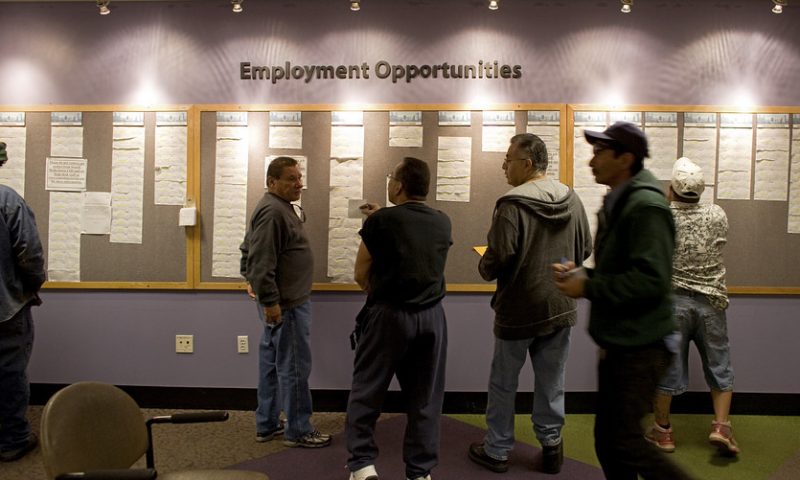U.S. unemployment falls to 3.5%, lowest since 1969
U.S. stocks closed higher Friday after the Labor Department’s monthly employment report calmed fears of a recession but provided enough evidence of a slowing economy to maintain market expectations for another Federal Reserve interest rate cut in late October.
After a rocky start to the week, stocks climbed for a second day Friday but the Dow and S&P 500 index still ended with a weekly loss, after Fed chair Jerome Powell said the economy “faces some risks” but is still “in a good place”.
How are benchmarks performing?
The Dow Jones Industrial Average DJIA, +1.42% rose 372.68 points, or 1.42%, to 26,573.72, the S&P 500 index SPX, +1.42% added 41.38 points, or 1.42% to 2,952.01 while the Nasdaq Composite COMP, +1.40% advanced 110.21 points, or 1.4%, to 7,982.47.
On Thursday, the Dow closed up 122.42 points, or 0.47%, at 26,201.04 while the S&P 500 index rose 23.02 points, or 0.8% to 2,910.63, and the Nasdaq Composite Index rose 87.02 points to 7,872.26, a gain of 1.12%.
For the week, the Dow lost 0.92% for a third week of declines, while the S&P 500 ended 0.33% lower also posting a third down week, but the Nasdaq managed at gain of 0.54% snapping a two week losing streak.
What’s driving the stock market?
The U.S. economy added 136,000 new jobs in September, slightly less than forecast, and the pace of job growth fell to the slowest in four months, but the U.S. unemployment rate dropped to 3.5%, the lowest rate since December 1969. The average job growth of 157,000 during the past three months is enough to keep the unemployment rate trending down.
“This is the classic definition of a ‘Goldilocks’ report,” Michael Arone, chief investment strategist at State Street Global Advisors told MarketWatch. “The rate of job growth is slowing, but the labor market continues to be a strength of the U.S. economy.”
Average hourly earnings for workers ticked down one cent to $28.09, after rising 11 cents in August. Yearly growth in wages fell to 2.9% from 3.2% in August.
“The one concern is that average hourly earnings ticked down a bit,” Arone said. “Some might take this as a positive as because wages aren’t rising enough to feed into inflation, and it will allow the Fed to cut rates again.”
Investors are placing a slightly lower chance that the Fed will cut interest rates at its next meeting ending Oct. 30, with the Fed-funds futures markets pricing an 80.7% chance of a cut later this month, down from about 90% before the report was released. The market is still placing a more than 91% chance of a cut by the end of 2019, however.
“Net, net, one single economic report may not be make or break for the Fed’s upcoming decision on whether to cut interest rates a third time this year, but the monthly jobs report is make or break for the economy and right now the jobs report is telling us the economy isn’t broken,” MUFG chief financial economist Chris Rupkey said in a note.
The jobs data held particular significance after reports about American factory activity showed evidence of contraction in September, with the Institute for Supply Management’s manufacturing report on Tuesday showing the weakest reading in about a decade and an ISM non-manufacturing report on Thursday, coming in at 52.6% — the weakest level in about three years.
“While we believe our strategy and tools have been and remain effective, the U.S. economy, like other advanced economies around the world, is facing some longer-term challenges—from low growth, low inflation, and low interest rates,” Powell said in a Washington D.C. speech Friday afternoon after the jobs data was released, adding the Fed is “examining strategies” that will help it achieve its inflation goal of 2%.
Investors were also watching developments on the trade front, and stocks added to their gains late Friday morning after President Trump told reporters at the White House that there was “a very good chance” that a deal could be reached between the U.S. and China. The two sides are set to meet for high level talks in Washington Oct. 10-11.
How are other markets trading?
Shares of Apple Inc. AAPL, +2.80% rose after a report in the Nikkei Asian Review that the company has asked suppliers to ramp up production of its latest iPhone 11 model by 10%, or 8 million units.
Costco Wholesale Corp. COST, +0.92% reported fiscal fourth-quarter earnings after the close Thursday, with earnings and revenue falling short of Wall Street estimates, though same-store sales growth of 5.1% matched expectations.
How are other markets trading?
The yield on the 10-year U.S. Treasury note TMUBMUSD10Y, -0.39% fell about one basis point to 1.522%.
Gold prices finished lower on Friday, suffering their first loss in four sessions, after the U.S. government reported only modest growth in September U.S. employment, but revealed that the nation’s unemployment rate dropped to its lowest level in 50 years. Gold for December delivery GCZ19, -0.23% slipped 90 cents to settle at $1,512.90 an ounce on Comex.
Oil futures settled higher Friday, with U.S. benchmark crude breaking an eight-day string of losses, but still posted its biggest weekly loss since mid-July, after a run of weak economic data underlined concerns over global demand. West Texas Intermediate crude-oil for November delivery CLX19, +1.07% rose 36 cents, to $52.81 a barrel on the New York Mercantile Exchange.

